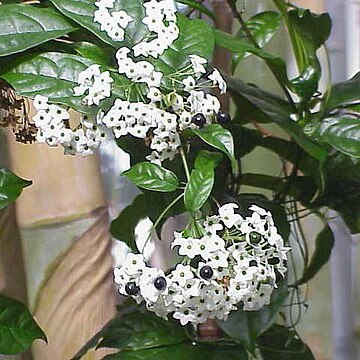Leaves 3–4-whorled; lamina 1.2–12.5(14) × 0.8–5.5 cm, ± narrowly oblong-elliptic to elliptic or lanceolate, acuminate to ± caudate at the apex, broadly cuneate to rounded at the base, entire, thin textured, dark green and glossy above, glabrous or puberulous only on the nerves beneath, distinctly 3-nerved from the base with first pair of lateral nerves inserted just at the lamina-base and somewhat stronger than the lateral nerves; petiole articulated where it rises from the woody basal part, 0.2–1.5 cm long, erect or ± spreading.
Inflorescence a terminal loose umbel-like corymb with a relatively short axis, up to 10 cm long and 16 cm in diameter in fruit, shortly pubescent, formed by small 1–few-flowered cymes on slender peduncles, the lower peduncles longest up to 7 cm long, spreading and finely puberulous.
Erect tufted rhizomatous suffrutex 40–100 cm high from a woody rootstock with stems numerous, annual, herbaceous becoming woody (in East Africa a shrub with scandent branches to 6 m long or small tree with spreading crown to 8 m).
Stems simple or few-branched towards the apex, petiole bases persisting as short woody obliquely truncate projections, puberulous on young growth, to glabrescent; internodes 3–7 cm long.
Calyx campanulate, puberulous or glabrous, pale green, strongly accrescent in fruit; tube 1.5–2.5 mm long; lobes 1.5–2 mm long, ovate-deltoid or oblong.
Corolla cream or cream-greenish, sweet-smelling, glabrous or puberulous outside; tube (3)5–8 mm long; lobes 2–4 × 1.5 mm, oblong.
Fruit c. 10 mm high, black (green or greenish-black when unripe), with juicy red flesh.
Minute flowers and horizontally branched inflorescences.
A climbing shrub


